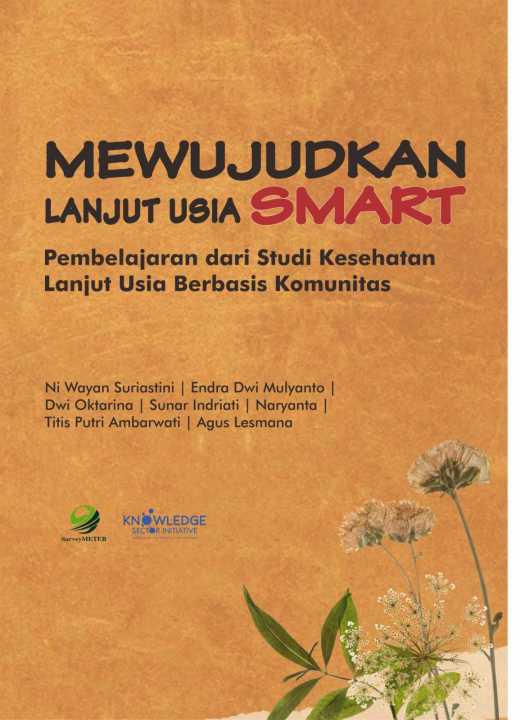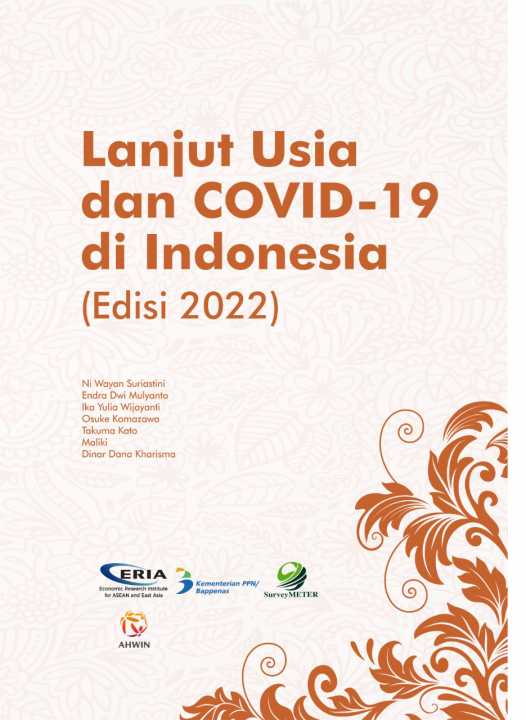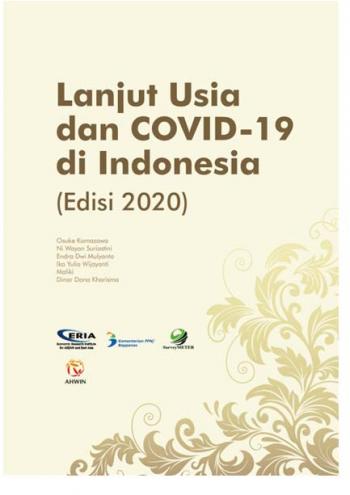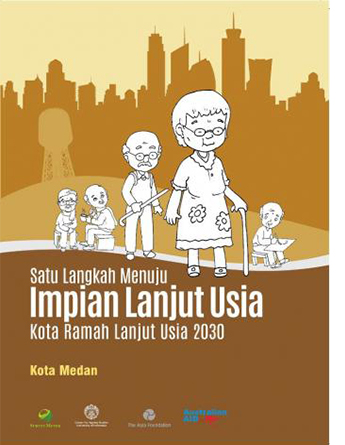Tanggal
27 July 2023
Kata Kunci
PAUD,Covid-19
Lokasi
SurveyMETER
Tipe
Buku
Penulis
Ni Wayan Suriastini, Fita Herawati, Cici Permata Rusadi, Dani Alfah, Indrawan Firdauzi, Setyo Pujiastuti, Sukamtiningsih.
Share Artikel:
Adaptation of ECED During the COVID-19 Pandemic

SurveyMETER carried out the ECED Adaptation Study during the COVID-19 Pandemic in the Special Region of Yogyakarta from January to March 2021, with the support of the Knowledge Sector Initiative (KSI). This study interviewed more than 1900 respondents who were school supervisors/administrators, school principals, teachers, and parents via telephone survey. The government was equipping school principals, teachers, and parents with an ECED learning module from home by prioritizing student involvement during online learning. It investigated the extent to which the policy intervention was rigorously proper and on target.
This study portrayed the gap in access to knowledge among stakeholders in early childhood education implementation during the COVID-19 pandemic. Parents and teachers should be the key actors in the ECED learning from home. Teachers are expected to equip parents through various game-based learning methods as an adaptation during the COVID-19 pandemic, such as in the 12 PAUD Learning Modules. Unfortunately, only a few of them use or know about these learning modules since most of the module owners and module training participants were not among those who directly accompany toddlers/children learning at home.
Here is the link to download the book for free:
Full version:
 Adaptasi PAUD Pada Masa Pandemi COVID-19
Adaptasi PAUD Pada Masa Pandemi COVID-19
Isi:
Tanggal
24 July 2023
Kata Kunci
Kesehatan dan Lanjut Usia
Lokasi
SurveyMETER
Tipe
Buku
Penulis
Ni Wayan Suriastini, Endra Dwi Mulyanto, Dwi Oktarina, Sunar Indriati, Naryanta, Titis Putri Ambarwati, Agus Lesmana.
Share Artikel:
Actualizing SMART Older Adults: Lessons from the Community-Based Elderly Health Study

Indonesia is currently experiencing an aging population. More than 10% of its population is elderly, with the highest percentage of 15.7% being in the Special Region of Yogyakarta (DIY). The government encourages community-based health service providers to possess the capacity to actualize a Healthy, Independent, Active, and Productive (SMART) elderly population in the policy sphere, one of which is through health screening. SurveyMETER, under the support of the Knowledge Sector Initiative (KSI), conducted a Community-Based Health Study by interviewing all Community Health Centers, 121 Posyandu for the Elderly, and 1,010 older adults Individuals in DIY in 2021.
This study reviews the scope of elderly health screening that is yet to comply with Minister of Health Regulation Number 4 of 2019, particularly that every older adult has the right to receive screening at least once a year. Screening coverage refers to the percentage of older adults receiving health screening at health centers, most of which have not reached 50% yet. There were only two screenings with better percentages: body mass index (51%) and vital sign measurement (54%). The rest are still relatively low, such as examination of egg albumen (23%), hemoglobin (28%), blood sugar (45%), cholesterol (44%), uric acid (44%), and cognitive status as an early detection of dementia (43 %). One of the reasons is the limited human resources and budget to prioritize elderly health screening at Puskesmas. This condition is accompanied by limited knowledge of certain screenings. For example, public knowledge (Posyandu for the Elderly 6% and older adults themselves 5%) about memory disorders as a symptom of dementia tends to be low since Puskesmas is the same provider. Dementia has been normalized as an aging process that is addressed not to require screening and medical treatment. This situation emphasizes that the elderly program has not yet become essential at the Puskesmas until the service is less than optimal, and, if persisted, could prevent the realization of a SMART elderly population.
In addition to the findings above, it also examines other interesting topics such as geriatrics training and long-term care at Puskesmas, as well as the dynamics of Posyandu for the older adults and the conditions of the elderly.
Here is the link to download the book complimentary.
Full version:
Isi:
 5. Langkah yang Diperlukan Guna Mewujudkan Lanjut Usia Smart Berbasis Komunitas
5. Langkah yang Diperlukan Guna Mewujudkan Lanjut Usia Smart Berbasis Komunitas
Tanggal
10 August 2022
Kata Kunci
Lanjut Usia dan COVID-19, Kesehatan dan Lanjut Usia
Lokasi
Indonesia
Tipe
Buku
Penulis
Ni Wayan Suriastini, Endra Dwi Mulyanto, Ika Yulia Wijayanti, Osuke Komazawa, Takuma Kato, Maliki, Dinar Dana Kharisma
Share Artikel:
Older Adults and COVID-19 in Indonesia (the 2022 Edition)

The second round of the telephone survey, 'Older Adults and COVID-19 in Indonesia' is a follow-up to the first wave of the study. It is a collaboration among ERIA, Bappenas, and SurveyMETER. This follow-up survey aims to (1) compare the health and well-being of older adults during the coronavirus disease (COVID-19) pandemic between July 2020 and November 2020, (2) compare the problems faced by the older adults during the COVID-19 pandemic between July 2020 and November 2020, (3) determine changes in assistance received by the older adults in response to the COVID-19 pandemic between July 2020 and November 2020, and (4) identify the most appropriate policies to mitigate the impact of the pandemic on the older adults, based on changes in the situation during the pandemic.
The findings show that some older adults still experienced a decline in income in November 2020. The impact of the pandemic on food consumption changed from July 2020 to November 2020. Fewer older adults received social assistance in November 2020 compared to July 2020. They preferred to receive social assistance by cash rather than by in-kind. Access to better health services results in accurate diagnoses until more older adults are identified as having physical health problems. In addition, their mental health has improved slightly. However, some respondents still experience problems accessing health facilities and a lack of routine medicines. The risk of social isolation decreases as the COVID-19 pandemic lasts, and a downward trend is also seen in the number of beneficiaries of some social supports. A community care hub with the help of digital technology is recommended to facilitate support for elderly needs with available services. This is also appropriate in a pandemic situation since it may lead to something to speed up service provision and reduce the risk of infection.
Here is the link to download the book complimentary.
The English version is available on the ERIA website: Bahasa Inggris
Full Version:
 Lanjut Usia dan COVID-19 di Indonesia (Edisi 2022)
Lanjut Usia dan COVID-19 di Indonesia (Edisi 2022)
Isi:
 Bab 1 Latar Belakang dan Tujuan
Bab 1 Latar Belakang dan Tujuan
 Bab 3 Ekonomi dan Perlindungan Sosial
Bab 3 Ekonomi dan Perlindungan Sosial
 Bab 5 Interaksi dan Dukungan Sosial
Bab 5 Interaksi dan Dukungan Sosial
 Bab 6 Kesimpulan dan Rekomendasi
Bab 6 Kesimpulan dan Rekomendasi
Tanggal
28 January 2022
Kata Kunci
Lansia Abad 21, Buku Lansia, Buku Kelanjutusiaan
Lokasi
SurveyMETER
Tipe
Aging Publikasi
Penulis
Wayan Suriastini, Bondan Sikoki, Endra Dwi Mulyanto, Titis Putri Ambarwati, Ragil Safitri, Naryanta, Jejen Fauzan, Rodhiah Umaroh, Achmad Budi Santoso, Adhi Santika, dkk
Share Artikel:
Compendium: Older Adults in the 21st Century

The book 'Compendium: Older Adults in the 21st Century' is a collaboration among investigators comprising researchers from SurveyMETER and Indonesian older adult observers who are members of the Coalition for Communities Caring for the Older Adults (KuMPUL). As the title suggests, the book discusses the latest dynamics of aging, enclosing the independence and actualization of the elders, globalization for them, as well as social protection and health services for older adults.
SurveyMETER researchers contributed significantly through four writing topics that reviewed public services and elderly health, the self-actualization of older adults, and the mainstreaming of aging. The following two articles have a comprehensive correlation because they both discuss the public dimension of the elders. Wayan Suriastini notably encourages us to learn about the urgency of long-term care (LTC), including homecare and daycare, by perceiving best practices in Japan, Thailand, and Singapore. Endra Mulyanto et al. also discussed the importance of providing an elderly-friendly environment for backstopping their mobility. This article also presents concrete proposals, such as optimizing village ambulance services, volunteering by residents to accompany older adults, providing incentives, and improving public transportation facilities for them.
The two other articles examine the intergenerational dimension of aging activities, although the correlation is moderate. Titis Putri Ambarwati et al. cleverly questioned the mainstreaming of older adults in formal education with the young generation's low concern level for the elders. This article shows that the participation of older adults in early, primary, and secondary education activities may ignite the younger generation's empathy for the aging process. Meanwhile, Naryanta et al. scrutinized the medium/mechanism of older adults in family medicinal garden plant cultivation activities (TOGA). This article depicts elderly figures who are tenacious in caring for TOGA medical gardens in their yards and then assesses that for such work will be more beneficial if carried out across generations.
Here is the link to download the book complimentary.
Full version:
 Bunga Rampai: Lansia di Abad 21
Bunga Rampai: Lansia di Abad 21
Isi:
 BAB 1: Lansia di Tengah Arus Globalisasi dan Pendidikan Kelanjutusiaan
BAB 1: Lansia di Tengah Arus Globalisasi dan Pendidikan Kelanjutusiaan
 Melek Literasi Digital untuk Lansia, Pentingkah?
Melek Literasi Digital untuk Lansia, Pentingkah?
 Mengintegrasikan Materi Kelanjutusiaan di Pendidikan Formal
Mengintegrasikan Materi Kelanjutusiaan di Pendidikan Formal
 BAB 2: Merancang Hidup Sehat Menuju Lansia Tangguh dan Prima
BAB 2: Merancang Hidup Sehat Menuju Lansia Tangguh dan Prima
 Menyiapkan Diri Sedini Mungkin Menjadi Lansia Tangguh
Menyiapkan Diri Sedini Mungkin Menjadi Lansia Tangguh
 Pentingnya Pendekatan Berpusat Kepada Kebutuhan Individu (PBKI) Bagi Lansia
Pentingnya Pendekatan Berpusat Kepada Kebutuhan Individu (PBKI) Bagi Lansia
 BAB 3: Menyongsong Kemandirian dan Kesejahteraan Lansia
BAB 3: Menyongsong Kemandirian dan Kesejahteraan Lansia
 Menghapus Stigma dan Diskriminasi karena Usia dalam Dunia Kerja
Menghapus Stigma dan Diskriminasi karena Usia dalam Dunia Kerja
 Rabun Jauh Kita untuk Bersiap Menjadi Lansia
Rabun Jauh Kita untuk Bersiap Menjadi Lansia
 BAB 4: Lansia Dalam Kreasi dan Aktualisasi Diri
BAB 4: Lansia Dalam Kreasi dan Aktualisasi Diri
 Aktualisasi Diri Lansia: Belajar dari Tokoh-Tokoh Lansia
Aktualisasi Diri Lansia: Belajar dari Tokoh-Tokoh Lansia
 Lanjut Usia Aktor Pelestari Tanaman Obat Keluarga
Lanjut Usia Aktor Pelestari Tanaman Obat Keluarga
 BAB 5: Lingkungan Ramah Lansia
BAB 5: Lingkungan Ramah Lansia
 Kota dan Kawasan Ramah Lanjut Usia
Kota dan Kawasan Ramah Lanjut Usia
 Lingkungan Ramah Lansia Penting Bagi Mobilitas Lansia
Lingkungan Ramah Lansia Penting Bagi Mobilitas Lansia
 BAB 6: Interseksionalitas Isu Lansia
BAB 6: Interseksionalitas Isu Lansia
 Meski Waria, Lansia Waria Tetaplah Lansia
Meski Waria, Lansia Waria Tetaplah Lansia
 BAB 7: Mainstreaming Kelanjutusiaan di Ranah Kebijakan
BAB 7: Mainstreaming Kelanjutusiaan di Ranah Kebijakan
 “Jauh Panggang Dari Api” Mempertanyakan Keberpihakan RANHAM Terhadap Hak-Hak Lansia
“Jauh Panggang Dari Api” Mempertanyakan Keberpihakan RANHAM Terhadap Hak-Hak Lansia
Tanggal
13 April 2021
Kata Kunci
Lanjut Usia dan COVID-19, Kesehatan dan Lanjut Usia
Lokasi
Indonesia
Tipe
Buku
Penulis
Osuke Komazawa, Ni Wayan Suriastini, Endra Dwi Mulyanto, Ika Yulia Wijayanti, Maliki, Dinar Dana Kharisma
Share Artikel:
Older Adults and COVID-19 in Indonesia

The telephone survey of Older Adults and COVID-19 in Indonesia is a collective initiative of ERIA, Bappenas, and SurveyMETER. This study aims to (1) measure senior citizens’ general knowledge about COVID-19; (2) compare the welfare of older adults before, during, and or after the COVID-19 pandemic; (3) understand the problems faced by older adults during the COVID-19 pandemic; (4) monitoring assistance received by them during the COVID-19 pandemic; and (5) identify policies needed to mitigate the impact of the pandemic on the older adults.
The findings of this study show that more than half of the older adults experienced a decline in income, especially those who depend on their income from work and their children's earnings. Significantly more senior citizens are receiving government assistance than before the pandemic. One in six senior citizens reported that their health declined during the pandemic, while a significant portion of older adults remain supportive of their social interactions despite the pandemic. The government is advised to strengthen its efforts by building a support system for older adults to realize the National Strategy for Aging vision.
Here is the link to download the book complimentary.
The English version is available on the ERIA website: Bahasa Inggris
Full Version:
 Lanjut Usia dan COVID-19 di Indonesia
Lanjut Usia dan COVID-19 di Indonesia
Isi:
 Bab 1 Latar Belakang dan Tujuan
Bab 1 Latar Belakang dan Tujuan
 Bab 3 Ekonomi dan Perlindungan Sosial
Bab 3 Ekonomi dan Perlindungan Sosial
 Bab 5 Interaksi dan Dukungan Sosial
Bab 5 Interaksi dan Dukungan Sosial
 Bab 6 Kesimpulan dan Rekomendasi
Bab 6 Kesimpulan dan Rekomendasi
Tanggal
22 October 2014
Kata Kunci
Kota Ramah Lanjut Usia, Lanjut Usia di Surakarta
Lokasi
Surakarta
Tipe
Buku
Penulis
SurveyMETER dan CAS UI
Share Artikel:
One Step towards the DREAM of ELDERLY-Friendly Cities for Senior Citizens in 2030 | Surakarta City

Based on baseline data from the 2013 Elderly-Friendly City Assessment Study, Surakarta City is conceivably described as a city expressly approaching being elderly-friendly.
Based on the color achievement category being adjusted to the percentage of community assessment scores stating Suitable and Very Suitable, the people of Surakarta City, broadly recognized as Solo City, gave the color yellow a score of 56%. This color category is based on a percentage assessment score, especially red features a percentage score of 0-25%, orange has a score of 26-50%, yellow has a score of 51-75%, and green has a score of 76-100%. The city people assess that of the eight dimensions, one is considered to represent green, four dimensions are yellow, two dimensions are orange, and one dimension is red. One dimension that is in the green category is the Social Participation dimension. One dimension of red and one color of orange is a weakness in the achievements of the City of Surakarta. Moreover, the yellow achievement score for the Building and Open Space and the Transportation dimensions are still unsafe (not safe, only slightly above 50%).
However, with this achievement, the expectation of actualizing Surakarta City becoming an elderly-friendly city is utterly fluent. Compared to other cities, Surakarta City received the highest assessment score. So, the excursion to achieve an Elderly-Friendly City in 2013 is moderately easy. If it is planned carefully, it will come true shortly.
What is a detailed description of the achievements of the eight dimensions of an elderly-friendly city in Surakarta City? How does this compare with the general situation in Indonesia? What are the recommended achievements and strategies for Surakarta City to become an Elderly-Friendly City by 2030? For details, please download.
One Step towards the DREAM of ELDERLY-Friendly Cities for Senior Citizens in 2030 | Surakarta City
Tanggal
22 October 2014
Kata Kunci
Kota Ramah Lanjut Usia, Lanjut Usia di Surabaya
Lokasi
Surabaya
Tipe
Buku
Penulis
SurveyMETER dan CAS UI
Share Artikel:
One Step towards the DREAM of ELDERLY-Friendly Cities for Senior Citizens in 2030 | Surabaya City

Berdasarkan data baseline Studi Asesmen Kota Ramah Lanjut Usia tahun 2013 Kota Surabaya dapat dikategorikan sebagai kota yang belum namun sudah melangkah menuju kota ramah lanjut usia.
Berdasarkan kategori pencapaian warna yang disesuaikan pada persentase skor penilaian masyarakat yang menyatakan Sesuai dan Sangat sesuai, masyarakat Kota Surabaya memberikan penilaian warna orange dengan bobot skor yang selangkah menuju kuning yaitu 46,3%. Masyarakat kota ini menilai dari 8 dimensi kota ramah lansia dua dinilai sudah berwarna kuning, belum ada yang hijau. Lima dimensi lainnya berwarna orange dan satu dimensi berwarna merah. Beberapa dimensi orange memiliki skor yang mendekati batas minimal warna kuning. Kelemahannya skor total satu dimensi warna merah masih terhitung rendah (13.8%) sehingga memengaruhi skor total.
Meski demikian, harapan untuk mewujudkan kota ramah lansia di Surabaya sudah terbuka. Modalnya, pada dua dimensi berwarna kuning dan dimensi warna orange yang sudah memperoleh skor cukup tinggi.
Bagaimana gambaran detail capaian 8 dimensi kota ramah lanjut usia di Kota Surabaya? Bagaimana jika dibandingkan dengan keadaan umum di Indonesia? Bagaimana rekomendasi pencapaian dan strategi untuk Kota Surabaya dalam mewujudkan Kota Ramah Lanjut Usia 2030? Selengkapnya silahkan unduh.
One Step towards the DREAM of ELDERLY-Friendly Cities for Senior Citizens in 2030 | Surabaya City
Tanggal
21 October 2014
Kata Kunci
Kota Ramah Lanjut Usia, Lanjut Usia di Payakumbuh
Lokasi
Payakumbuh Sumatra Barat
Tipe
Buku
Penulis
SurveyMETER dan CAS UI
Share Artikel:
Satu Langkah Menuju IMPIAN LANJUT USIA Kota Ramah Lanjut Usia 2030 | Kota Payakumbuh
 Berdasarkan data baseline Studi Asesmen Kota Ramah Lanjut Usia tahun 2013 Kota Payakumbuh dapat dinarasikan sebagai kota yang hampir ramah lanjut usia.
Berdasarkan data baseline Studi Asesmen Kota Ramah Lanjut Usia tahun 2013 Kota Payakumbuh dapat dinarasikan sebagai kota yang hampir ramah lanjut usia.
Berdasarkan kategori pencapaian warna yang disesuaikan pada persentase skor penilaian masyarakat yang menyatakan Sesuai dan Sangat sesuai, masyarakat Kota Payakumbuh memberikan penilaian warna kuning meskipun dengan bobot skor yang relatif masih rendah yaitu total 55,1%. Masyarakat kota ini menilai, dari delapan dimensi kota ramah lansia satu di antaranya dinilai sudah berwarna hijau, empat dimensi berwarna kuning, dua dimensi orange, dan satu dimensi merah. Satu warna merah dan juga dua warna orange ini menjadi kelemahan capaian Kota Payakumbuh. Apalagi skor capaian dimensi Partisipasi Sipil dan Pekerjaan yang masih merah ini relatif masih rendah (kurang dari 17%).
Dengan capaian ini, harapan untuk mewujudkan Kota Payakumbuh menjadi kota ramah lansia sudah cukup lempang. Bahkan kalau direncanakan dengan matang akan terwujud dalam waktu tidak lama. Dan, untuk mewujudkannya lebih cepat perlu aksi nyata dan dukungan dari semua pihak. Tidak hanya pemerintah namun diperlukan keterlibatan pihak swasta dan semua kelompok masyarakat.
Bagaimana gambaran detail capaian 8 dimensi kota ramah lanjut usia di Kota Payakumbuh? Bagaimana jika dibandingkan dengan keadaan umum di Indonesia? Bagaimana rekomendasi pencapaian dan strategi untuk Kota Payakumbuh dalam mewujudkan Kota Ramah Lanjut Usia 2030? Selengkapnya silahkan unduh.
Satu Langkah Menuju IMPIAN LANJUT USIA; Kota Ramah Lanjut Usia 2030 | Kota Payakumbuh
Tanggal
21 October 2014
Kata Kunci
Kota Ramah Lanjut Usia, Lanjut Usia di Medan
Lokasi
Medan
Tipe
Buku
Penulis
SurveyMETER dan CAS UI
Share Artikel:
Satu Langkah Menuju IMPIAN LANJUT USIA Kota Ramah Lanjut Usia 2030 | Kota Medan
 Berdasarkan data baseline Studi Asesmen Kota Ramah Lanjut Usia tahun 2013 Kota Medan dapat dinarasikan sebagai kota yang masih sangat jauh dari kota ramah lansia.
Berdasarkan data baseline Studi Asesmen Kota Ramah Lanjut Usia tahun 2013 Kota Medan dapat dinarasikan sebagai kota yang masih sangat jauh dari kota ramah lansia.
Berdasarkan kategori pencapaian warna yang disesuaikan pada persentase skor penilaian masyarakat yang menyatakan Sesuai dan Sangat sesuai, masyarakat Kota Medan memberikan penilaian warna oranye dengan skor sangat rendah yaitu total 26,6% atau hanya 2% di atas batas warna merah. Masyarakat kota ini menilai dari 8 dimensi tidak ada satu pun yang dinilai sudah berwarna kuning, apalagi hijau. Rinciannya, 4 dimensi berwarna orange dan 4 dimensi berwarna merah. Bahkan skor total semua dimensi warna orange masih rendah, yaitu di kisaran 31-36%.
Meski demikian, harapan untuk menjadi kota ramah lansia bukan berarti tidak ada sama sekali. Modalnya adalah semua dimensi yang berwarna orange dan capaian warna merah tidak ada skor yang di bawah 10%. Tetapi untuk mewujudkan kota ramah lansia pada 8 dimensi tersebut perlu kerja keras yang nyata dari semua pihak, tidak hanya pemerintah namun juga keterlibatan pihak swasta dan semua elemen masyarakat.
Bagaimana gambaran detail capaian 8 dimensi kota ramah lanjut usia di Kota Medan? Bagaimana jika dibandingkan dengan keadaan umum di Indonesia? Bagaimana rekomendasi pencapaian dan strategi untuk Kota Medan dalam mewujudkan Kota Ramah Lanjut Usia 2030? Selengkapnya silahkan unduh.
Satu Langkah Menuju IMPIAN LANJUT USIA; Kota Ramah Lanjut Usia 2030 | Kota Medan
Tanggal
20 October 2014
Kata Kunci
Kota Ramah Lanjut Usia, Lanjut Usia di Mataram NTB
Lokasi
Mataram NTB
Tipe
Buku
Penulis
SurveyMETER dan CAS UI
Share Artikel:
Satu Langkah Menuju IMPIAN LANJUT USIA Kota Ramah Lanjut Usia 2030 | Kota Mataram
 Berdasarkan data baseline Studi Asesmen Kota Ramah Lanjut Usia tahun 2013 Kota Mataram dapat diklasifikasikan kota yang belum cukup tetapi potensial beranjak menjadi kota ramah lanjut usia dalam waktu tidak lama.
Berdasarkan data baseline Studi Asesmen Kota Ramah Lanjut Usia tahun 2013 Kota Mataram dapat diklasifikasikan kota yang belum cukup tetapi potensial beranjak menjadi kota ramah lanjut usia dalam waktu tidak lama.
Berdasarkan kategori pencapaian warna yang disesuaikan pada persentase skor penilaian masyarakat yang menyatakan Sesuai dan Sangat sesuai, masyarakat Kota Mataram memberikan penilaian warna oranye dengan skor total 44,1%. Masyarakat kota ini menilai dari 8 dimensi separuhnya sudah dinilai berwarna kuning, yaitu mendapat skor penilaian antara 50%-75%. Sisanya, 3 dimensi berwarna orange, 1 dimensi berwarna merah. Dimensi dengan capaian merah pun memiliki total skor capaian yang mendekati warna orange, hampir 22%. Kelemahannya, dimensi Perumahan yang berwarna orange masih mendapat skor yang nyaris menyentuh skor warna merah (26%) yang mempengaruhi capaian total 8 dimensi.
Namun demikian dengan capaian ini, harapan untuk menjadi kota ramah lansia lebih mudah diwujudkan. Modalnya sudah signifikan, raihan total skor hampir 45% sudah di atas total skor Indonesia yang baru menyentuh 43%. Tentunya, untuk mewujudkan kota ramah lansia pada 8 dimensi tersebut perlu aksi nyata dan dukungan dari semua pihak, tidak hanya pemerintah namun diperlukan juga keterlibatan pihak swasta dan semua elemen masyarakat.
Bagaimana gambaran detail capaian 8 dimensi kota ramah lanjut usia di Kota Mataram? Bagaimana jika dibandingkan dengan keadaan umum di Indonesia? Bagaimana rekomendasi pencapaian dan strategi untuk Kota Mataram dalam mewujudkan Kota Ramah Lanjut Usia 2030? Selengkapnya silahkan unduh.
Satu Langkah Menuju IMPIAN LANJUT USIA; Kota Ramah Lanjut Usia 2030 | Kota Mataram